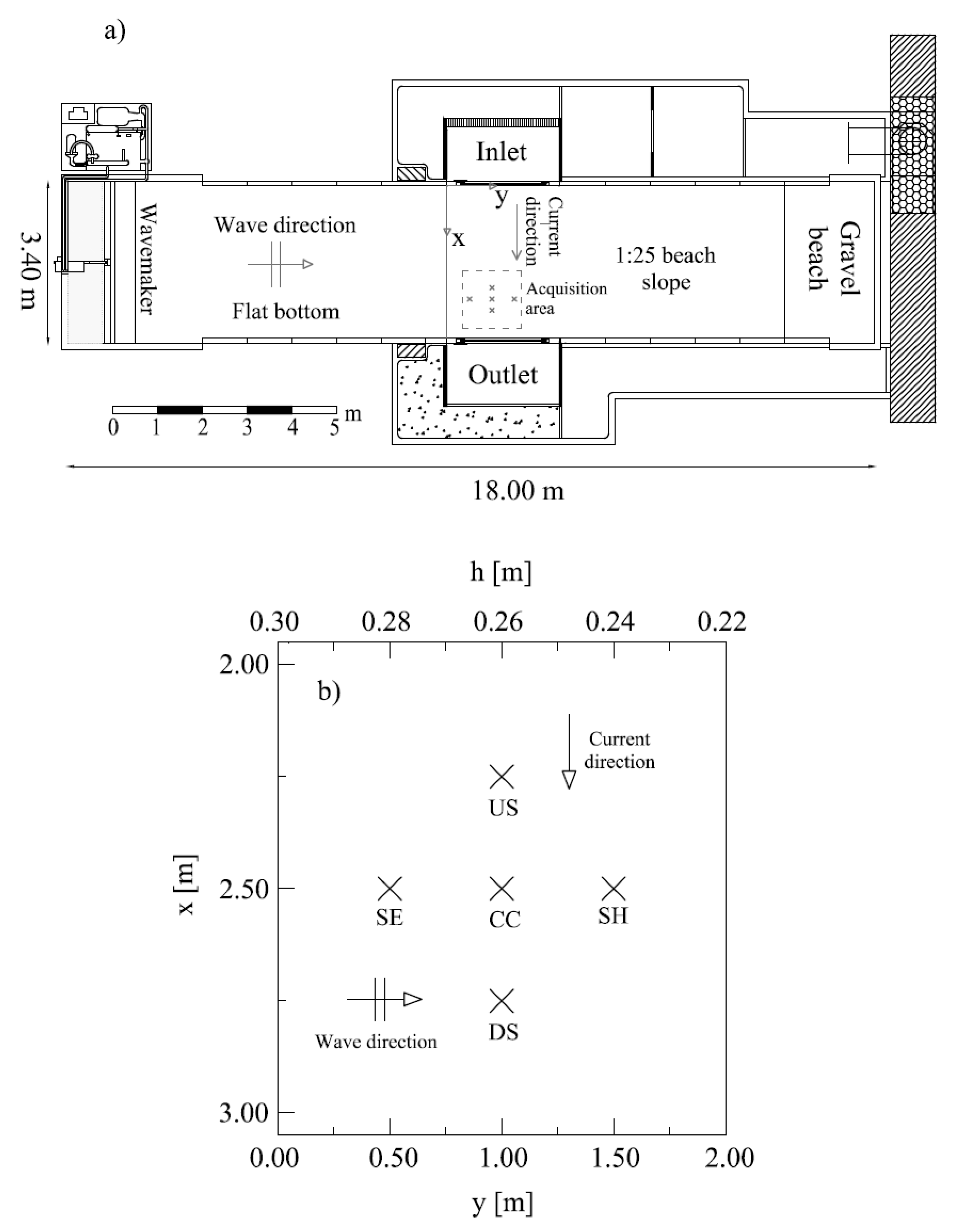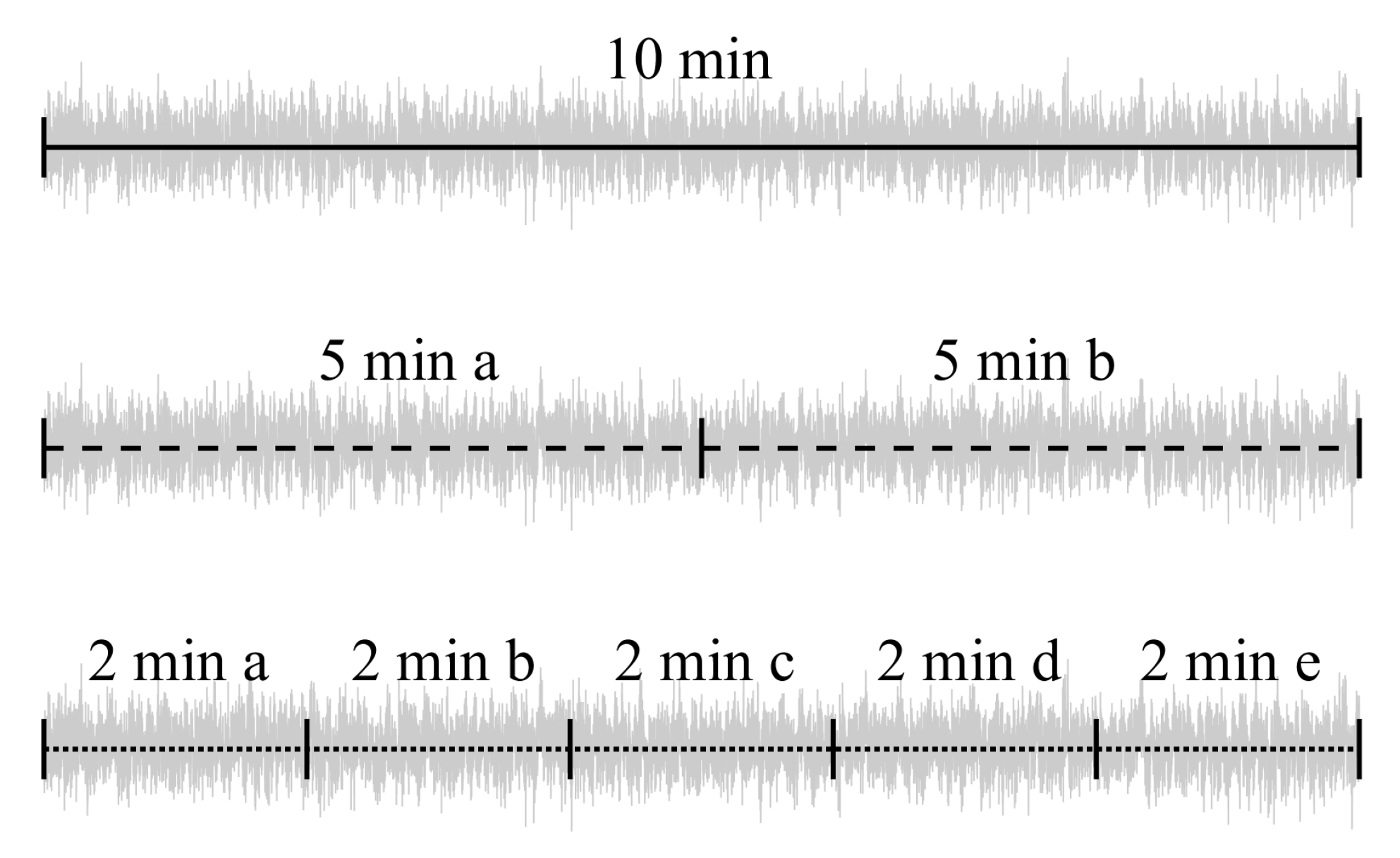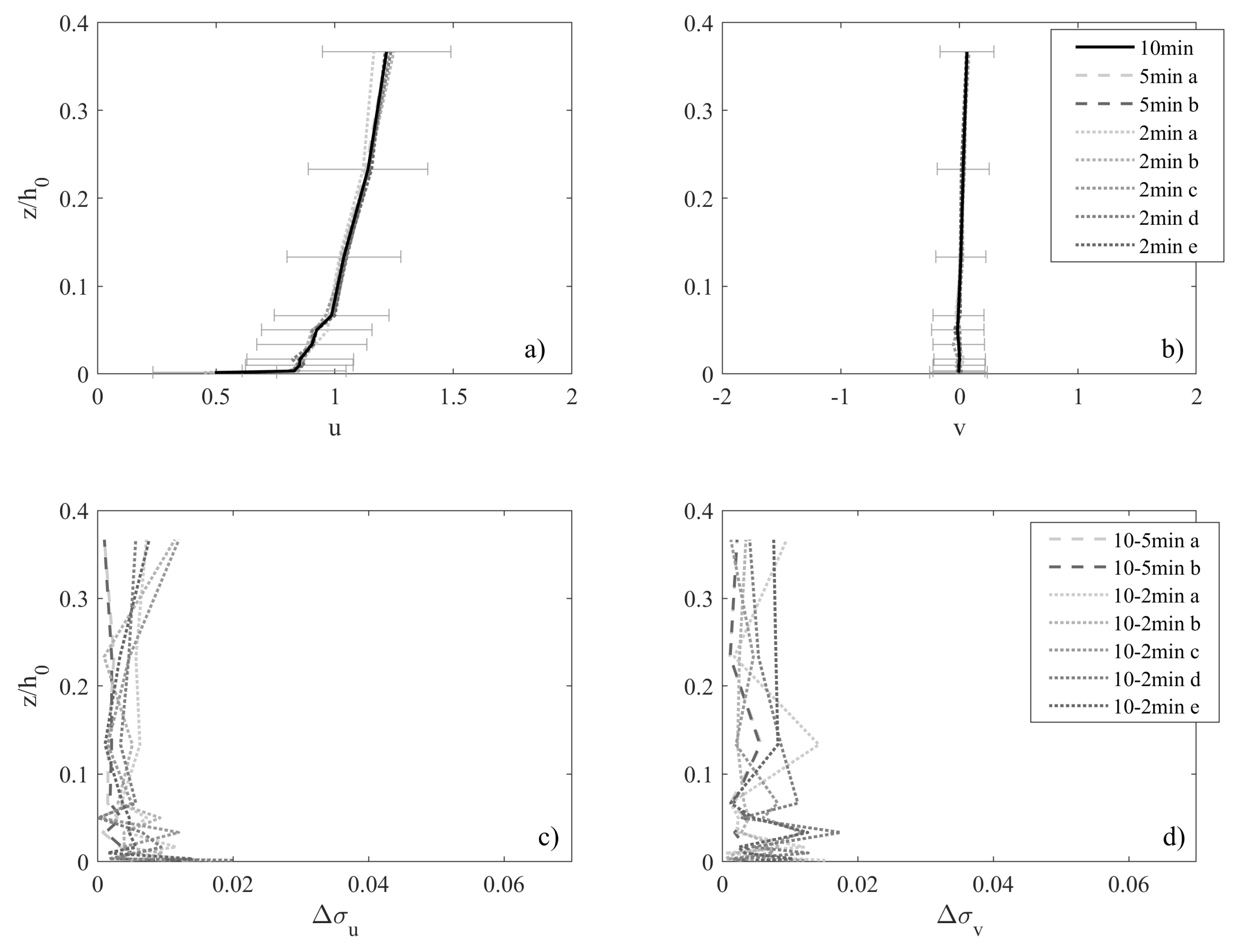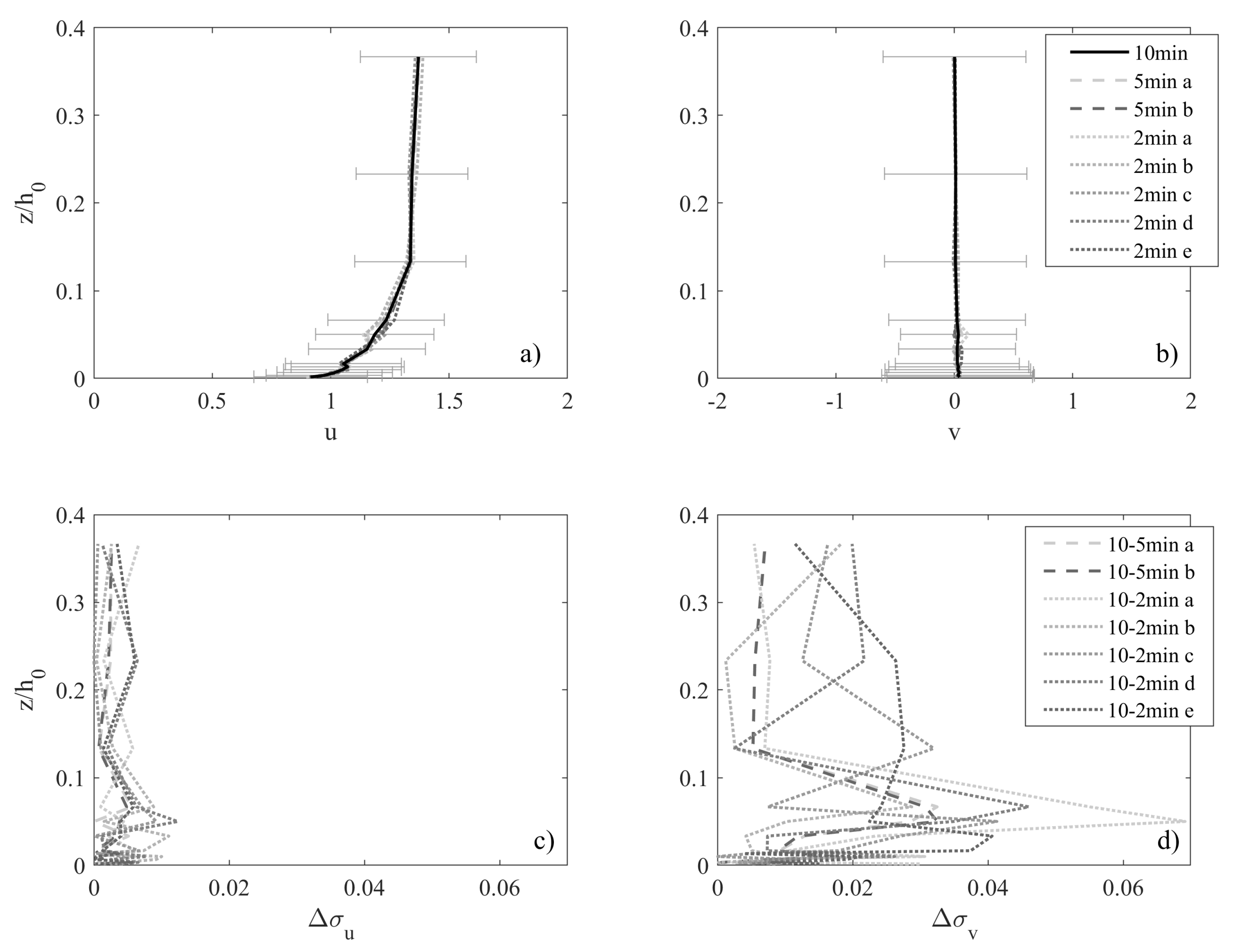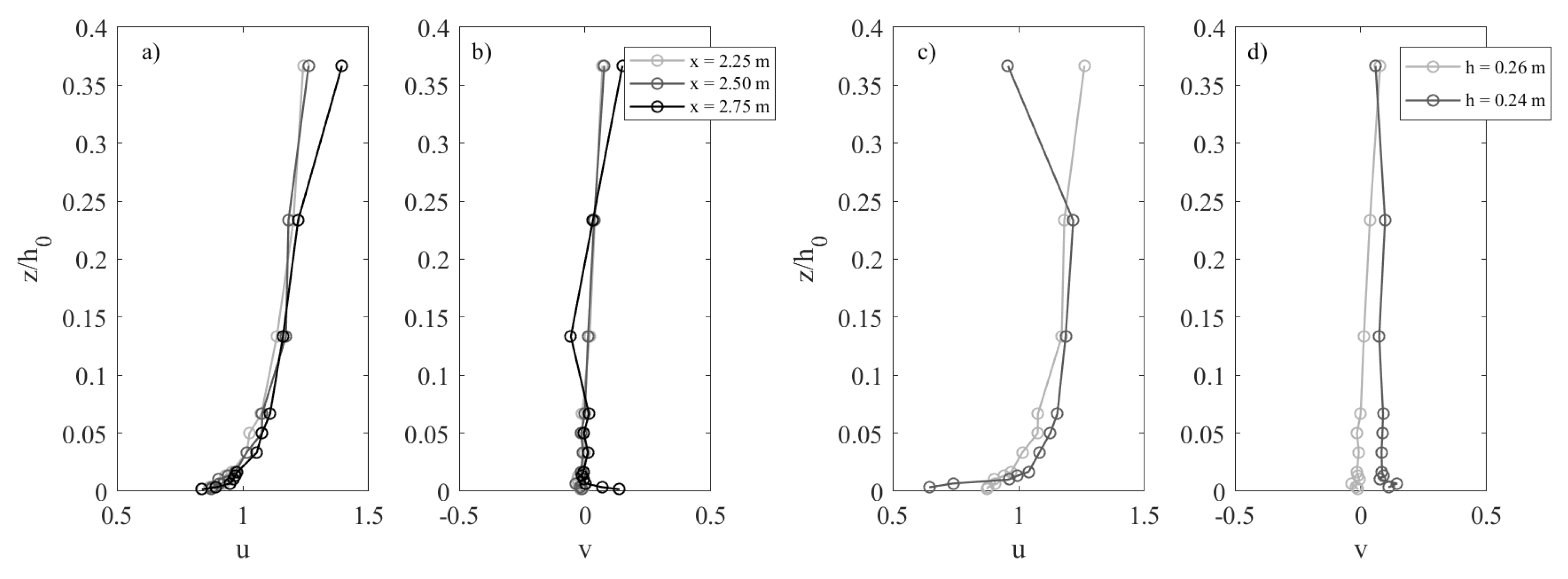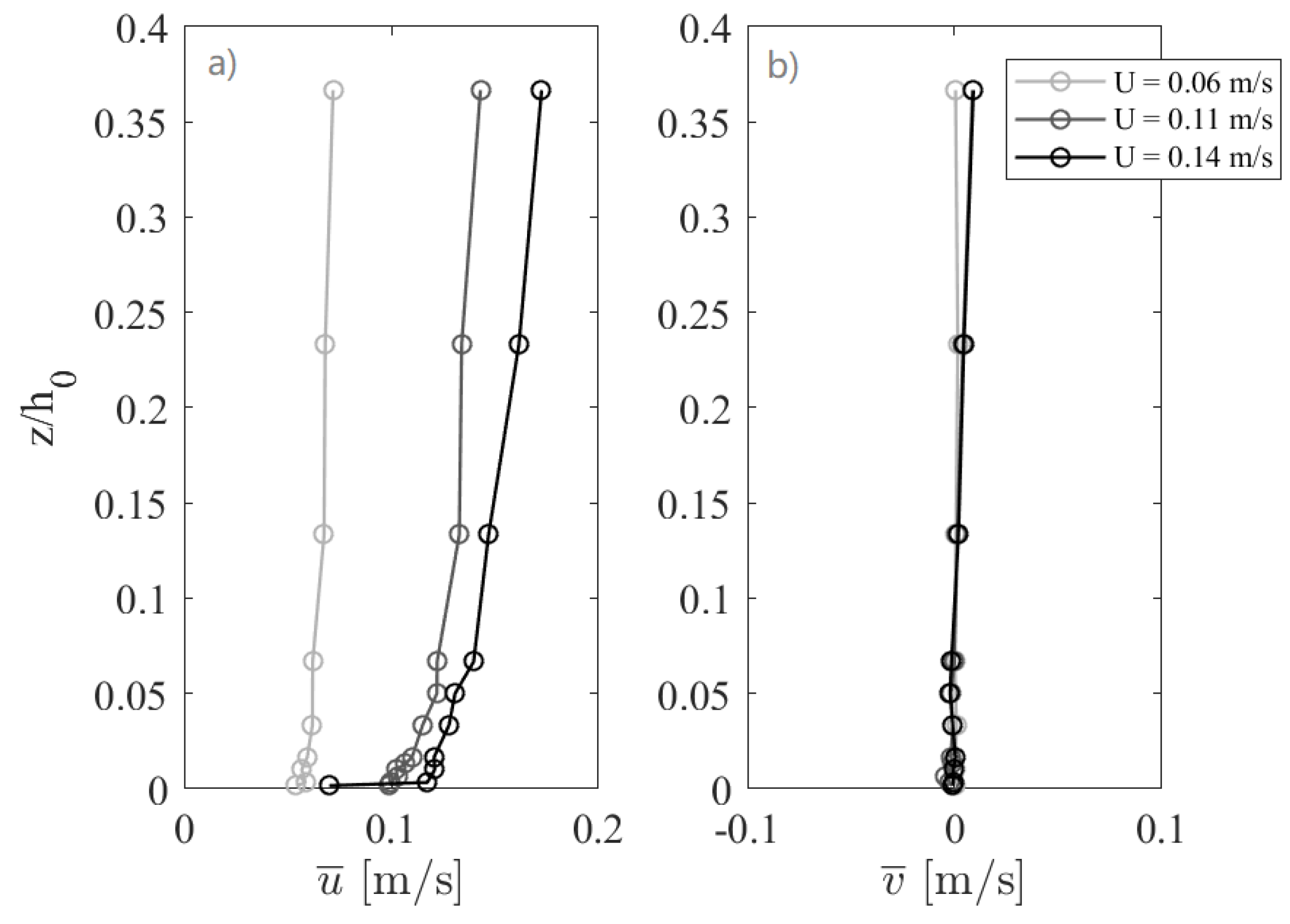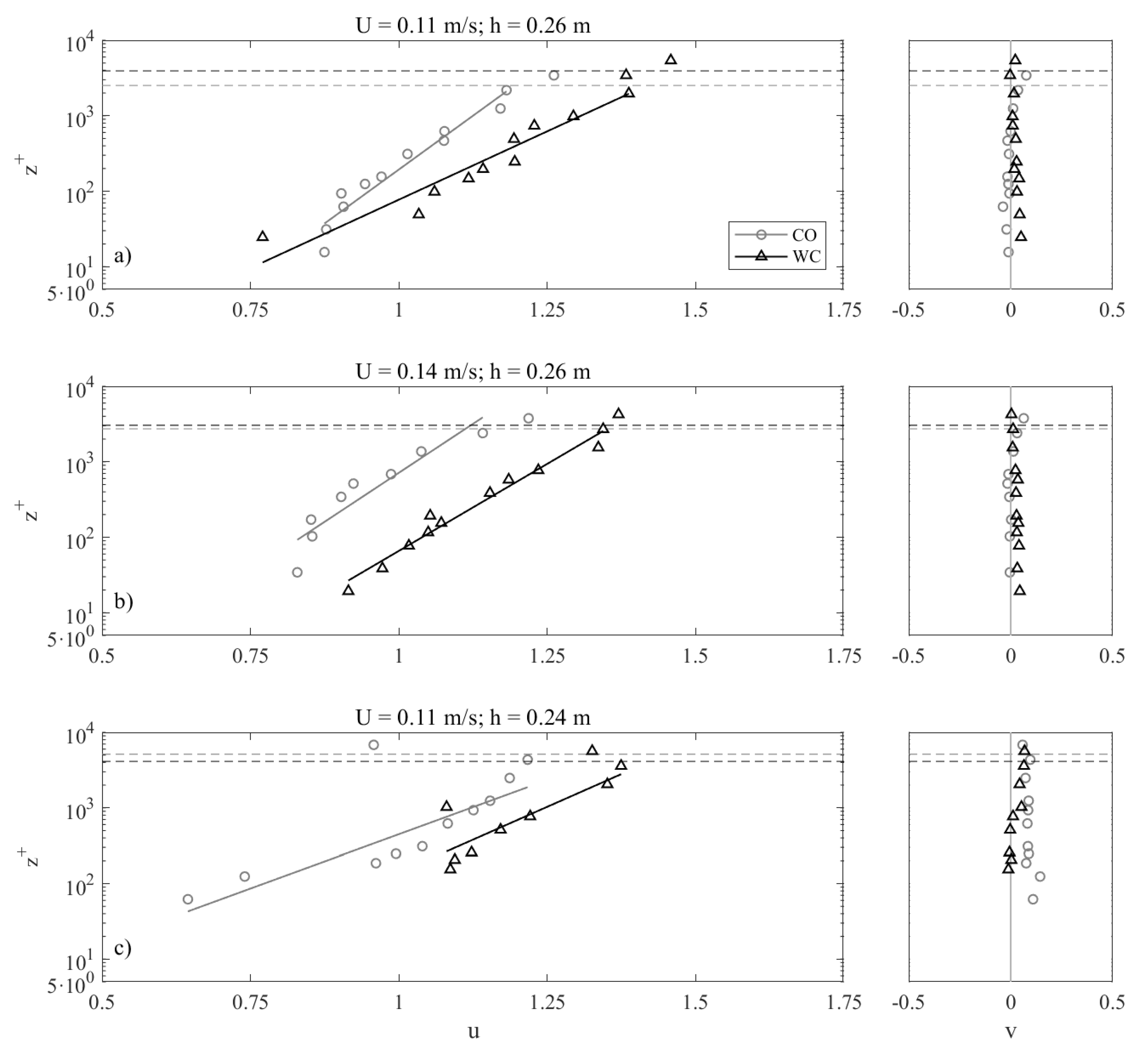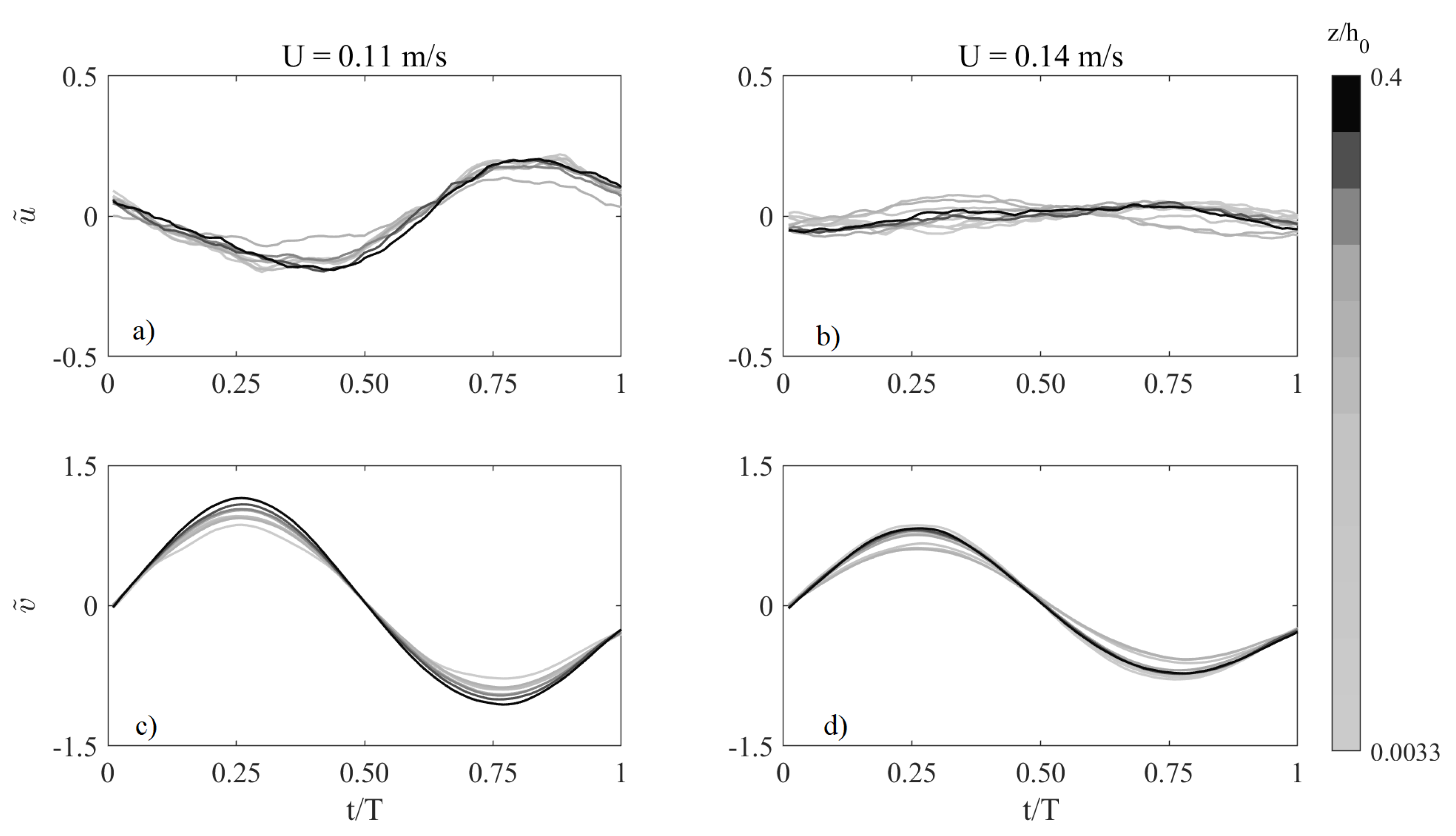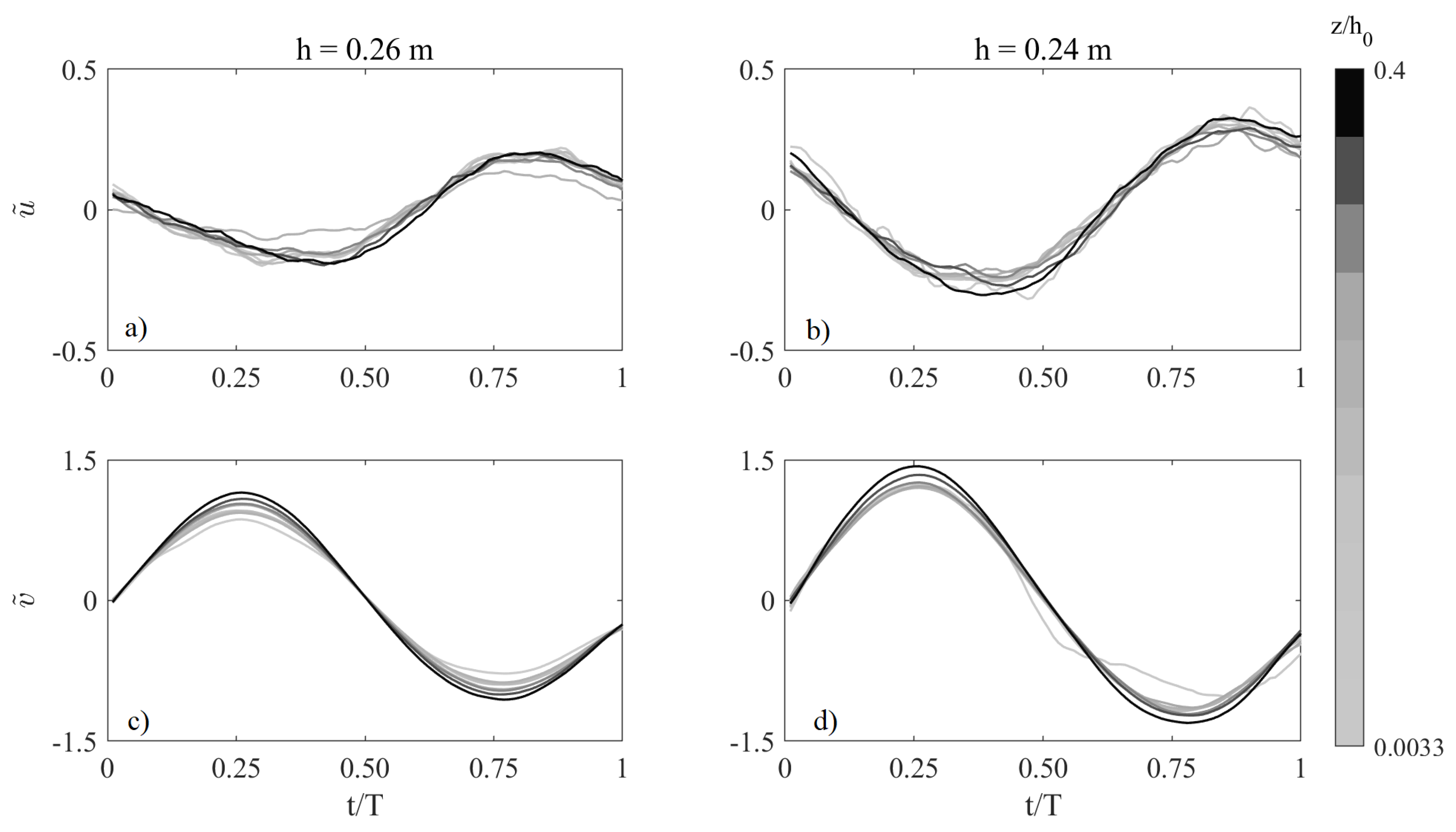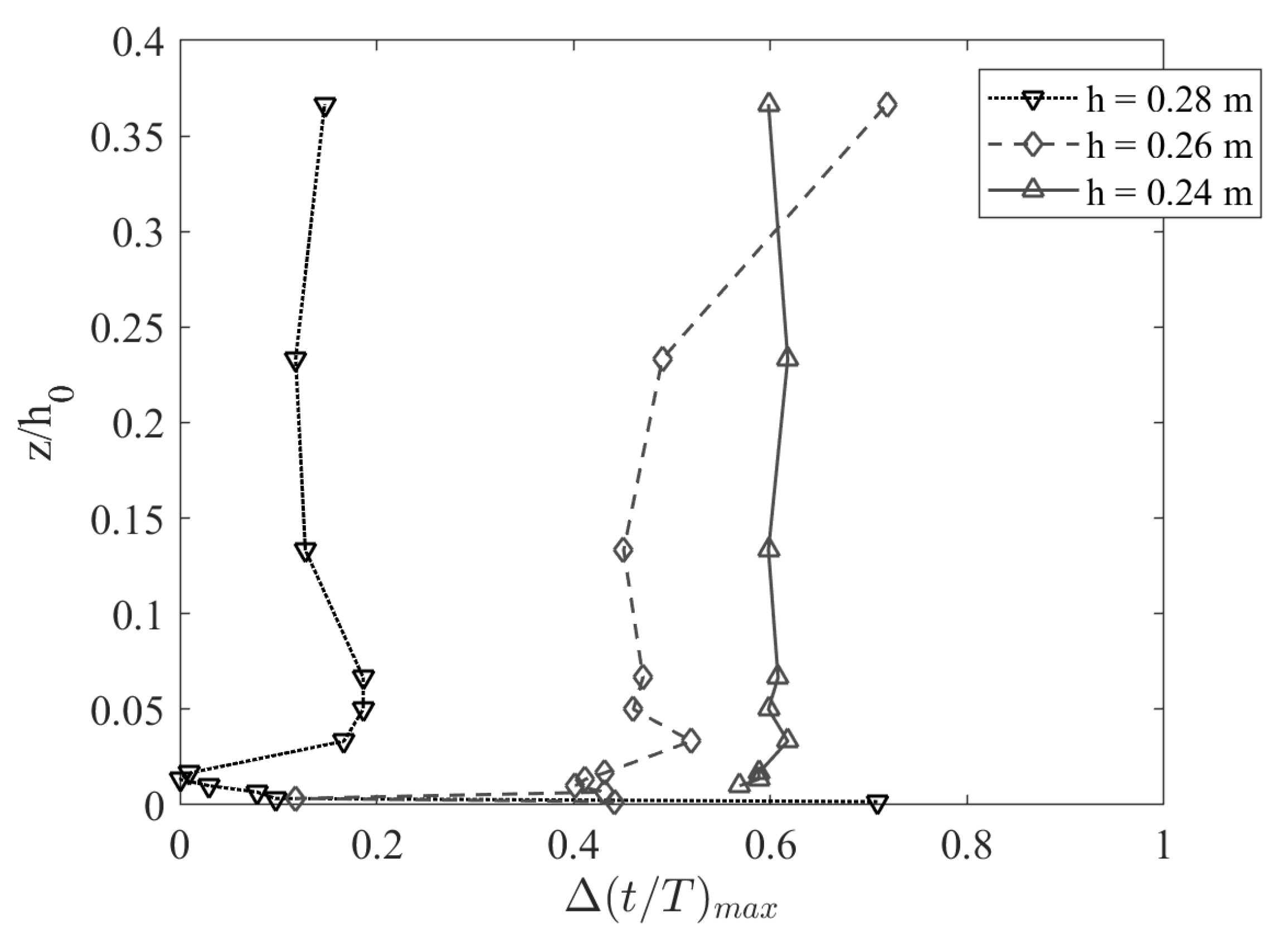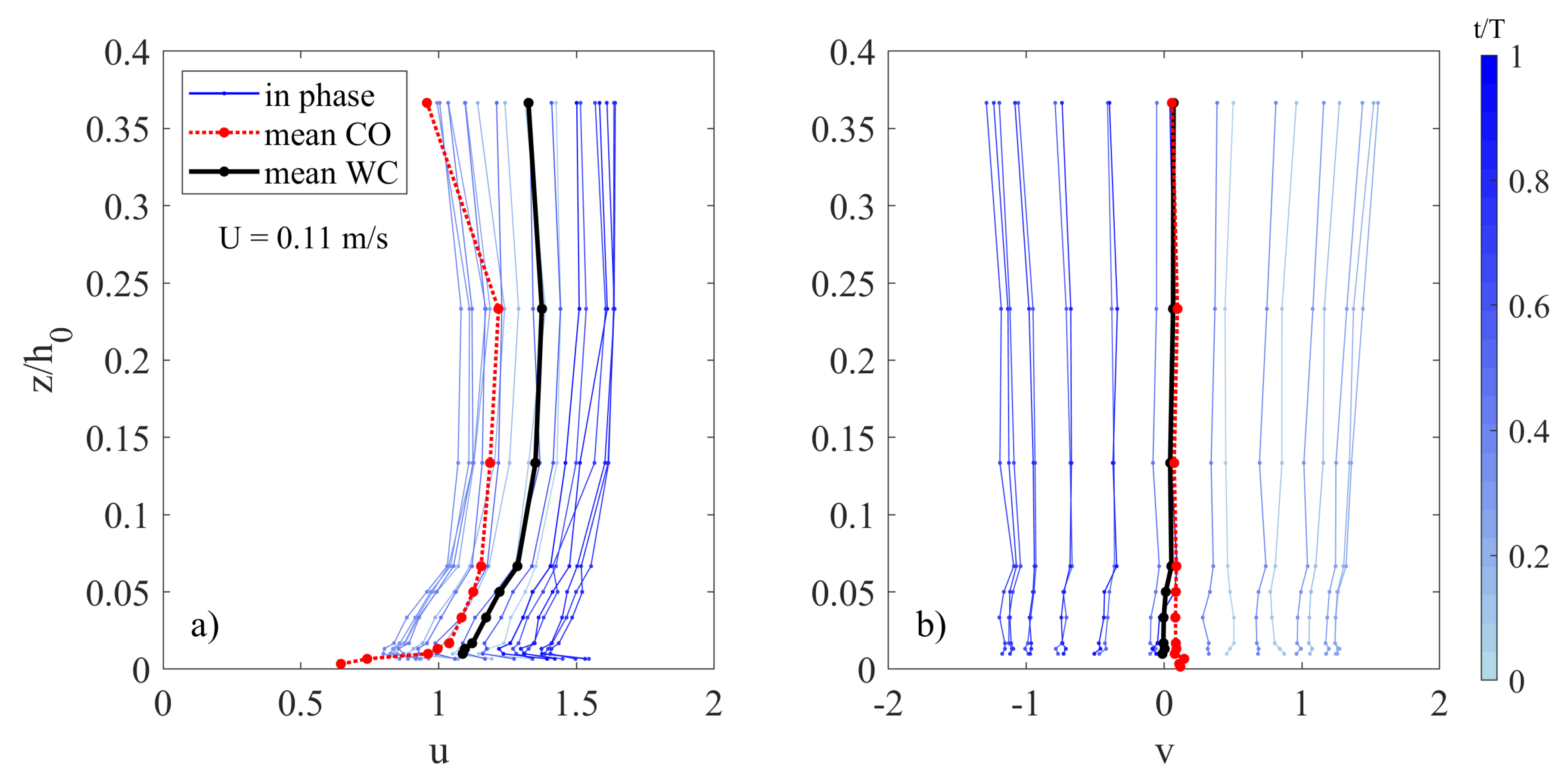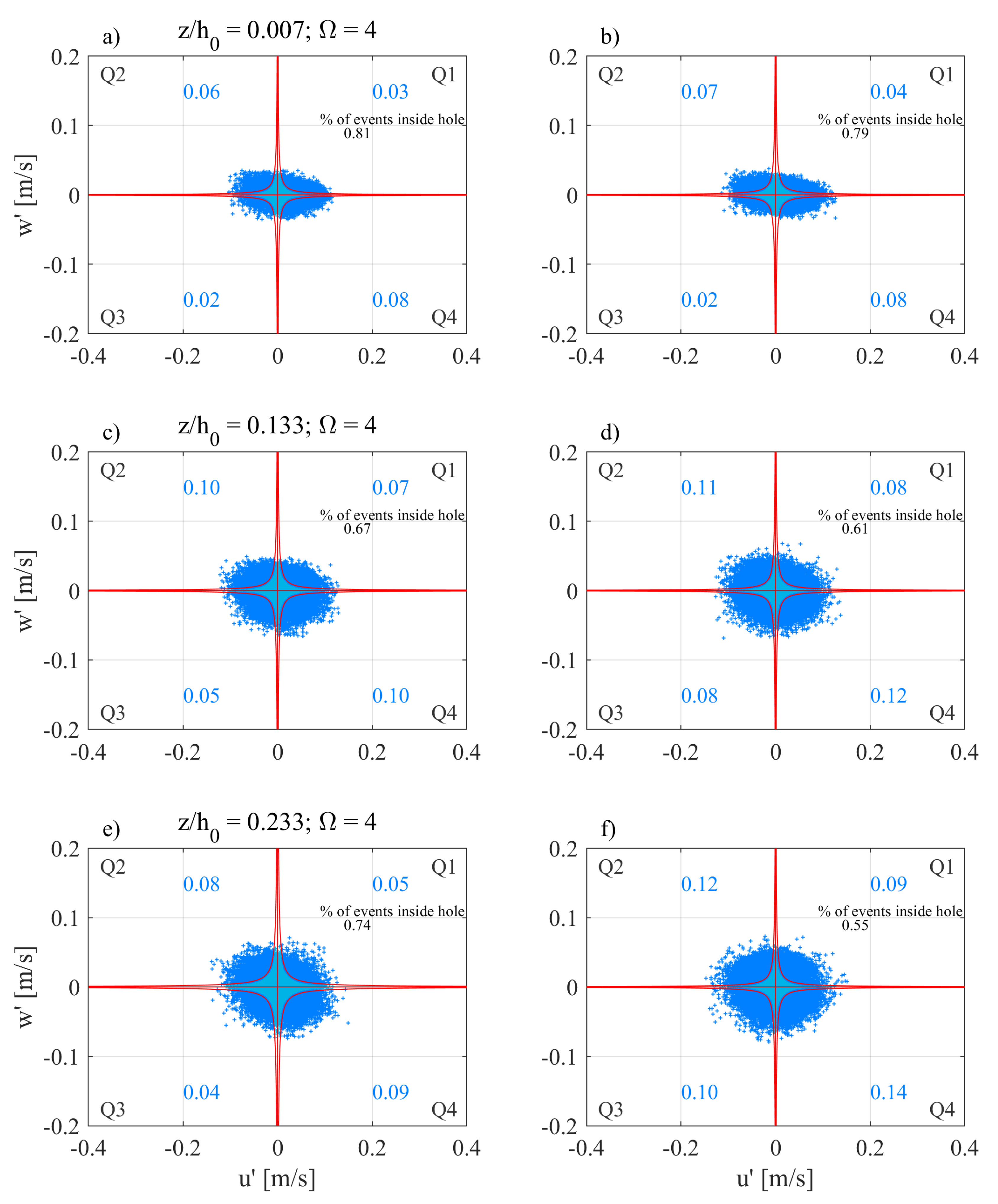In this section, the results of velocity data analysis are presented and discussed. First, an assessment of the temporal variability of the velocity time-series is shown in order to investigate time variability of the flow field and how it is altered by the presence of the waves. Then, a space variability assessment of the velocity is presented in order to investigate the flow at different positions within the tank. Subsequently, time- and phase-averaged velocity data of CO and WC tests are compared and the results are discussed. In the last subsection turbulent flow is investigated through quadrant analysis.
3.1. Time Variability Assessment
Velocity time series has been subdivided into smaller intervals and then a statistical analysis has been performed in order to assess the time-series variability considering different time spans. Similar approaches have been adopted by [
6,
21]. Duration of the measured velocity time series is 10 min, which has been divided in 2 segments of 5 min each (called 5 min a, 5 min b) and in 5 segments of 2 min (called 2 min a, 2 min b, 2 min c, 2 min d, 2 min e) as shown in
Figure 2.
Dimensionless time-averaged velocities
u (=
),
v (=
) and
w (=
), where
,
and
are the dimensional time-averages of
,
and
, have been computed from the original 10 min time series. The dimensionless time-averaged velocities of the smaller time segments (5 and 2 min) have been computed, namely:
,
and
, which are the 5 min segment time-averages of the dimensionless streamwise, crosswise and vertical velocity, where
s is some specific segment (namely a or b); and
,
and
, which are the 2 min time-averages of the dimensionless streamwise, crosswise and vertical velocity, where
s indicates some specific segment (namely a–e). In order to compare the variability of the different time spans, the deviation of the dimensionless time-averaged velocities computed from a shorter time series compared to the one computed from the entire time series, have been calculated:
Deviations of the time-averaged velocities for crosswise and vertical velocities are computed as well using the same notation. In a similar way, the variability of the standard deviation has been evaluated as:
where
is the standard deviation of
for the 10 min time series,
is the standard deviation of the 5 min time series for the segment
s (a or b),
is the standard deviation of the 2 min time series for the segment
s (a, b, c, d or e). Standard deviation differences for crosswise and vertical velocities are computed as well using the same notation.
Figure 3 shows the dimensionless time-averaged velocities for test 3 (CC, CO,
U = 0.14 m/s) of
u (
Figure 3a) and
v (
Figure 3b) for the following timespans: 10 min (continuous line), 5 min (dashed lines), 2 min (dotted lines); error bars indicate standard deviation for the 10 min time series
.
Figure 3a shows that time-averaged velocity profiles are quite similar for all the considered timespans. This suggests that the steadiness of the current is mantained for the entire duration of each experiment even for the smallest examined time segment, with a depth-averaged
< 0.01,
< 0.02 and a maximum of 0.06. Standard deviation
shown by the error bars is quite similar at every measuring position
z, with depth-averaged mean of 0.23 (±0.02). The dimensionless time-averaged velocity profiles of
v in
Figure 3b show a behavior similar to the one of
u, with depth-averaged
< 0.01 and
< 0.02 and a maximum of 0.05. Standard deviation
by the error bars is again quite similar at every measuring position
z with a depth-averaged value of 0.24 (±0.01).
Figure 3c shows the difference of standard deviation of the 10 min time series versus the 5 min one (
, dashed line) and the 2 min one (
, dotted lines) for test 3 (CO, CC,
U = 0.14 m/s) for streamwise (
Figure 3c) and crosswise (
Figure 3d) velocity. Results indicate that
is always below 0.01, with larger deviation peaks observed at the bottom below
= 0.1. The proximity of the bed may determine local turbulent fluctuations which disappear as a result of the time average as the test duration increases. Nevertheless, the difference between the two 5 min tests is relatively small for all the considered time spans. Standard deviation differences of the crosswise velocity in (
Figure 3d) show a very similar behavior, which is below 0.02 all along the water column and for all the time spans.
Figure 4 shows the dimensionless time-averaged velocity profiles for test 9 (WC, CC,
U = 0.14 m/s) of streamwise (
Figure 4a) and crosswise (
Figure 4b) velocity for the following time spans: 10 min (continuous line), 5 min (dashed line) and 2 min (dotted line); error bars indicate standard deviation of the 10 min time series. Measuring position and current mean velocity
U are the same as test 3, but in test 9 waves are superimposed to the current.
Error bars in
Figure 4a shows that the presence of waves does not induce a significant change of long-term variability, since the depth-averaged
is 0.24 (± 0.01), i.e., equal to the one in the absence of waves. Difference in time-averaged velocity
and
are below 0.01 and 0.02 respectively, as for test 3.
Figure 4b shows that the presence of the superposed oscillatory motion determines an increase of variability in terms of
(depth-averaged 0.08 ± 0.01) in comparison with
Figure 3b. Variability between time spans
is, however, lower than the current only case (< 0.01 for both 5 and 2 min time spans), this suggests the occurrence of a wave-induced turbulent momentum transfer from the wave to the current direction.
Figure 4 shows standard deviation differences for streamwise (
Figure 4c) and crosswise (
Figure 4d) velocity profiles for test 9. Comparison between
Figure 3c and
Figure 4d shows variability between time spans is quite similar to the ones already observed in the current only case. On the other hand,
Figure 4d shows instead a significant increase in standard deviation variability between time spans in the crosswise direction, which may reach 0.07 close to the bottom.
3.2. Spatial Variability Assessment
An investigation aimed at studying the flow field at different positions in the wave tank for the CO cases, i.e., at different water depth and along the current, has been performed.
Figure 5a,b shows the dimensionless time-averaged
u and
v velocity profiles in the streamwise and crosswise directions for the CO tests 2, 4 and 5, (CC, US and DS respectively), thus at measuring positions all aligned in the current direction (
y = 1.00 m), having the same local water depth
h = 0.26 m.
Figure 5a shows that a steady unidirectional current in the
x direction is satisfactorily achieved, as the velocity profiles aligned in the
x direction have the same velocity distribution along the water column. The upper part of the velocity profile at DS shows an increase in velocity in comparison with the other two positions. As this position is closer to the current outlet, the flow may be affected by the presence of a slightly faster current downstream of the outflow section, which may determine the upper part of the profile to be accelerated. Nevertheless, the depth-averaged difference between dimensionless time-averaged velocities is less than 0.01 of
U.
Figure 5b shows the dimensionless time-averaged velocity profiles
u and
v for tests 2 and 6, (CC and SH respectively) thus both aligned in the
y direction (
x = 2.50 m), with local water depth
h = 0.26 m and 0.24 m respectively.
Figure 5b shows that
u velocity profile of test 6 (SH,
h = 0.24 m), which is more shoreward and has a shallower depth in comparison with test 2 (CC,
h = 0.26 m), shows a velocity decrease close to the bed and an increase in the central part of the water column. Indeed, as the discharge of the mean current velocity is constant and the local water depth is shallower, the current shows an overall velocity increase as an effect of mass continuity. Due to the increase of velocity, an increased bottom resistance is experienced by the current, which shows a more turbulent velocity distribution in proximity of the bottom, compensated by a velocity increase in the rest of the water column. Velocity profiles of
v show that a mean flow directed shoreward is observed all along the water column. This suggests that at the positions shoreward from the central axis of the inflow/outflow sections (
y = 1.00 m), a recirculation region may be generated inside the tank, determining the current to veer in the shoreward direction. This veering effect is indeed not observed along the central axis while may reach a maximum value of 10% of
U at SH.
Figure 6 shows the dimensional time-averaged velocities
and
for CO tests 1, 2 and 3 which are at the same position in the tank (CC) but have different mean current velocity
U, equal to 0.06, 0.11 and 0.14 m/s respectively.
It can be observed that the u velocity distribution follows the increase of mean velocity U. The increase of U determines the velocity distribution to be altered, determining progressively larger turbulence-induced flow resistances at the bottom as U increases, showed by the increase of the velocity gradient in the vertical direction. Velocity profiles in the crosswise direction v show values close to zero for all tests along the whole water column, indicating that the current remains unidirectional at y = 1.00 m even with increasing mean current velocity. Moreover, no veering in the crosswise direction is observed, showing that the velocity field at y = 1.00 m (CC, US and DS) is not affected by the recirculation region for all the considered mean current velocities.
3.3. Time- and Phase-Averaged Flow
A comparative analysis of CO and WC time- and phase-averaged velocity profiles is carried out in the following, in order to investigate how the mean current flow is affected by the presence of waves.
Figure 7a shows the logarithmic profiles of
u and
v for tests 2 (CO) and 8 (WC), at CC with
U = 0.11 m/s. Velocities are plotted versus the dimensionless bed distance
, where
is the shear velocity. Shear velocity is calculated by the slope of a linear fit of the velocity measurements in the logarithmic profile [
30]. Dashed lines indicate the current boundary layer thickness
for the CO (grey) and WC (black) conditions, the continuous line shows the linear fitting of the velocities inside the logarithmic layer.
Figure 7a shows that in comparison with the CO case, the superposition of waves determines a velocity increase along the water column (depth-averaged
=
= 0.18). This suggests the occurrence of a mean momentum transfer from the wave to the current, thus from the
y to the
x direction. Moreover, the WC velocity distribution show a more turbulent profile (
= 0.05 m/s) in comparison with the CO case (
= 0.02 m/s), determined by an increase of bottom resistance due to the superposition of the wave boundary layer on the current, which enhances turbulence mixing in the proximity of the bed.
Figure 7b shows the logarithmic profiles of
u and
v for tests 3 (CO) and 9 (WC) with
U = 0.14 m/s. Both tests are at CC. The position is the same of tests 2 and 8, whose logarithmic profiles are shown in
Figure 7a, but in the presence of a stronger current, a larger transfer of mean momentum in the
x direction (depth-averaged
= 0.30). Moreover, the slopes of the two logarithmic profiles are quite similar (
= 0.03 m/s for the CO case,
= 0.04 m/s for the WC case); in this case, the superposition of waves apparently does not determine an increase in turbulent mixing. Since the sole current is stronger than the case shown in
Figure 7a (
= 37184 for test 2,
= 44857 for test 3), and the wave-current velocity ratio
is slightly smaller (
= 1.36 for test 2,
= 1.17 for test 3), it is possible that the presence of a stronger current inhibits the turbulent mixing induced by the wave motion.
Figure 7c shows the logarithmic profiles of
u and
v for tests 6 (CO) and 12 (WC) with
U = 0.11 m/s at SH, thus at a shallower water depth than the tests shown in
Figure 7a,b, but with the same
U of the test shown in
Figure 7a. The presence of waves still determines an overall velocity increase of the current (
= 0.08) but to a lesser extent than
Figure 7a. Similarly to the case of
Figure 7b, the superposition of waves does not induce an increase of turbulence in the proximity of the bed (
= 0.05 m/s for test 6,
= 0.06 m/s for test 12). It is possible that, at this condition, as the effect of waves on the water column becomes more relevant as wave shoals (
= 1.71), a partial relaminarization process occur. In other words, the presence of waves may determine a suppression of turbulent mixing. This phenomenon has been already observed by Lodahl et al. [
3] when a laminar wave boundary layer is superposed to a current with
> 1. Logarithmic profiles of
v in
Figure 7c show that the CO case presents a mean flow in the shoreward direction, as an effect of the recirculation flow, as already observed in
Section 3.2. Nevertheless, with the waves superposed on the current, this effect is reduced. As the presence of waves determines the generation of an undertow current in the seaward direction, which opposes the above recirculation effect.
Dimensionless phase-averaged current and wave velocities
and
have been computed as follows:
where
is the number of waves used for the computation of the phase average.
Figure 8 shows the dimensionless phase-averaged velocities
(
Figure 8a,b) and
(
Figure 8c,d) for tests 9 and 10. The two tests share the water same depth (
h = 0.26 m) but have different mean current velocity:
U = 0.11 m/s (
Figure 8a,c),
U = 0.14 m/s (
Figure 8b,d) respectively. The wave characteristics are
H = 0.085 m,
T = 1.0 s.
Figure 8a shows that the presence of waves determines an oscillatory flow to occur in the current direction. During the crest phase, defined as the half-cycle between 0 and 0.5
T, a current velocity decrease is observed, whereas during the trough phase, defined as the half-cycle between 0.5
T and 1, an increase of velocity of the current is observed. The oscillatory flow in the current direction is found to be out of phase with respect to the wave motion. The phase shift of the crests of
and
can be quantified by the absolute value of the difference between the instant
corresponding to the maximum of
and
correspondent to the maximum of
:
Comparison between
Figure 8a,b suggests that the presence of a stronger current (
U = 0.14 m/s) determines the wave motion to induce a less significant oscillation of
, i.e., the amplitude of
is reduced in comparison with the weaker current case. Moreover, phase-averaged current velocities show a smaller phase shift at the bottom in comparison with the rest of the water column (
Figure 8b). As current experiences a larger bottom resistance (
= 0.04 m/s) than the case with a weaker current (
= 0.03 m/s,
Figure 8a), it is possible that slower parts of the fluid close to the bed are more easily affected by the wave motion, whereas the faster ones in the upper part of the flow may experience a delay.
Figure 9 shows the phase-averaged velocities
(
Figure 9a,b) and
(
Figure 9c,d) for tests 9 and 12, the two tests share the same mean current velocity (
U = 0.11 m/s) but measurements were obtained at different water depths:
h = 0.26 m (
Figure 9a,c),
h = 0.24 m Figure (
Figure 9b,d) respectively. The wave characteristics are
H = 0.085 m,
T = 1.0 s.
The data in
Figure 9b,d reflect the fact that that wave shoaling is occurring between the two positions (CC and SH, respectively). A larger oscillation is observed as an effect of wave shoaling all along the measured water column. Moreover, a larger phase shift is observed (depth-averaged
= 0.60) in comparison with test 9 (
= 0.38). A possible explanation is the following: as waves shoal, the wave velocity distribution during a wave phase becomes more skewed, i.e., the absolute value of the wave acceleration during the crest phase increases. On the other hand, as the mean current velocity increases with decreasing depth, the current opposes to the acceleration induced by the wave motion. Indeed, as the momentum carried by the current increases as depth decreases, it is less prone to be affected by the change of velocity induced by the shoaling waves, determining the oscillating effect on the current to be delayed.
In order to observe how phase shift varies along the water column at different depths, the phase shift profiles of
for tests 13, 11 and 12 (
h = 0.28 m, 0.26 m and 0.24 m respectively) are shown in
Figure 10.
As depth decreases, the depth-averaged phase shift of maximums increases from 0.15 (for h = 0.28 m) to 0.60 (for h = 0.24 m). The current responds to the increasing nonlinearity of the wave velocity distribution with an inertial effect which induces a delay in the phase shift between current and wave oscillations. Moreover, in the lower part of the water column a decrease of phase shift is observed for every profile, although progressively less significant as depth decreases. It can be argued that, as the lower part of the current fluid moves slower, the flow in this region is more prone to move at the same phase of the wave.
Figure 11 shows the dimensionless phase-averaged and time-averaged velocity profiles for test 8 (WC) and the dimensionless time-averaged velocity profile for test 2 (CO) in the current (
Figure 11a) and wave (
Figure 11b) direction. Both profiles are measured at the central position and mean current velocity
U = 0.11 m/s.
The results indicate that the presence of waves induces current velocities to oscillate around their time-averaged
u. The upper part of the velocity profile experiences a decrease in velocity during the crest phase, and an increase of velocity during the trough phase, as already observed in
Figure 8 and
Figure 9.
Figure 12 shows the dimensionless phase-averaged and time-averaged velocity profiles for test 12 (WC) and the dimensionless time-averaged velocity profile for test 6 (CO) in the current (
Figure 12a) and wave (
Figure 12b) direction. Both tests are at shoreward position and mean current velocity
U = 0.11 m/s.
By comparing
Figure 12a and
Figure 11a, a more intense oscillatory motion of the current is determined by the presence of waves, as wave shoaling at this position is determining wave velocity amplitude to increase. This again induces a decrease of velocity during the crest phase and an increase during the trough phase. Such a decrease of velocity forces the current to slow down below the CO measured velocities. Therefore, the current experiences an overall (depth-averaged) velocity increase, but slows down during the crest phase below the CO
u profile.
3.4. Turbulent Flow
Wall turbulence manifests with the presence of coherent structures determined by velocity gradients in the boundary layer. Their presence heavily affects mean flow velocity and alters momentum transport, determining an increase of shear resistance. Turbulence production at a wall boundary is generated by the succession of two cyclic events: ejections (or bursts) and sweeps [
31]. These events are the main responsible for turbulent vertical momentum transport and they determine the most of the generation of the Reynolds shear stress [
32]. Quadrant analysis is a well-established technique to observe the behavior of the ejection-sweep cycle [
33,
34,
35]. Turbulent events, defined as the fluctuating velocities
of a time series, where
and
are the streamwise and vertical upward turbulent velocities, are subdivided into four quadrants depending on the signs of
and
. The first quadrant (Q1), where
,
, is called the outward interaction quadrant, the second quadrant (Q2), where
and
, is the ejections quadrant, the third quadrant (Q3), where
and
, is the inward interaction quadrant and the fourth quadrant (Q4), where
and
, is the sweeps quadrant. In a steady flow, the contribution of the
i-th quadrant at any point, excluding a hyperbolic region of size
, is
where the indicator function
is
In particular, is a threshold parameter which allows to consider as ejections-sweep events only the values of that are larger than times . The threshold parameter is used to observe the relative importance of the quadrant events in generating significantly strong shear stress.
Figure 13a,c,e shows the correlation plots for
and
for test 3 (CO, CC,
U = 0.14 m/s) whereas
Figure 13b,d,f shows the correlation plots for test 9 (WC, CC,
U = 0.14 m/s), at different distances from the bottom:
= 0.007 (
Figure 13a,b),
= 0.133 (
Figure 13c,d),
= 0.233 (
Figure 13e,f). The percentage of events occurring in each quadrant are indicated (light blue), excluding a central hyperbolic region with threshold
. The study has been carried out by varying the threshold parameter
, although in
Figure 13 only the hole region with
= 4 is shown.
Comparison between CO (
Figure 13a,c,e) and WC (
Figure 13b,d,f) shows that, at every considered
an increase in the relative number of ejection events is always observed when waves are added. This suggests that the presence of waves enhances turbulent mixing all along the water column. In the lower part of the water column (
Figure 13e,f) the overall shape of the correlation plot is fairly elliptical in the direction of the Q2 and Q4 quadrants. This suggests that turbulent events distribution is skewed in the direction of the Q2 and Q4, showing that turbulent momentum transfer at the wall is mainly driven by ejection (Q2) and sweep (Q4) events, only a slight difference can be observed between CO and WC case. As distance from bottom increases (
Figure 13c,d) the overall shape of the turbulent events overall shape turns from elliptical to almost circular. Turbulent events relatively diminishes in the Q2 and Q4 quadrants in favor of quadrants Q1 and Q3. The turbulent momentum transfer progressively leaves the ejections-sweeps cycle as a main mechanism of turbulent mixing to a more isotropic behavior. The presence of waves enhances turbulent ejections, but also outward and inward interactions. Moreover, the hole region associated with the Reynolds stress
decreases in size, and the number of events inside the hole decreases likewise. In the upper part of the water column (
Figure 13e,f) turbulent events distribution is even less elliptical. Here, the presence of waves determines an overall increase of turbulent fluctuations in all quadrants. Moreover, the presence of waves leads to a smaller Reynolds stress value, as the hyperbolic threshold is lower in the WC case.
